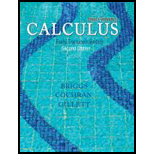
Explain why or why not Determine whether the following statements are true and give an explanation or counterexample.
- a. A function could have the property that f(−x) = f(x), for all x.
- b. cos (a + b) = cos a + cos b, for all a and b in [0, 2π].
- c. If f is a linear function of the form f(x) = mx + b, then f(u + v) = f(u) + f(v), for all u and v.
- d. The function f(x) = 1 − x has the property that f(f(x)) = x.
- e. The set {x: |x + 3| > 4} can be drawn on the number line without lifting your pencil.
- f. log10(xy) = (log10 x)(log10 y)
- g. sin−1 (sin (2π)) = 0
a.
Whether the given statement is true and give an explanation or a counter example.
Answer to Problem 1RE
The given statement is true.
Explanation of Solution
Given:
The given statement is “A function could have a property that
Calculation:
Consider the function
Now, check whether the above mentioned function satisfies the property
Therefore, the statement is true.
b.
Whether the given statement is true and give an explanation or a counter example.
Answer to Problem 1RE
The statement is false.
Explanation of Solution
Given:
The given identity is “
Calculation:
Take
Similarly, calculate the right hand side of the identity as follows.
That is,
Therefore, the statement is false.
c.
Whether the given statement is true and give an explanation or a counter example.
Answer to Problem 1RE
The statement is false.
Explanation of Solution
Given:
The given statement is “If
Calculation:
Take
The right hand side of equation
And, the left hand side of equation
Thus,
Therefore, the statement is false.
d.
Whether the given statement is true and give an explanation or a counter example.
Answer to Problem 1RE
The statement is true.
Explanation of Solution
Given:
The given statement is “The function
Calculation:
Consider the function
Calculate
Therefore, the statement is true.
e.
Whether the given statement is true and give an explanation or a counter example.
Answer to Problem 1RE
The statement is false.
Explanation of Solution
Given:
The given statement is “The set
Calculation:
The given set
Therefore, the set
Therefore, the statement is false.
f.
Whether the given statement is true and give an explanation or a counter example.
Answer to Problem 1RE
The statement is false.
Explanation of Solution
Given:
The given statement is “The equation,
Calculation:
Take,
Similarly, calculate the right hand side of the equation as shown below.
Then,
Therefore, the statement is false.
g.
Whether the given statement is true and give an explanation or a counter example.
Answer to Problem 1RE
The statement is true.
Explanation of Solution
Given:
The given statement is “The equation,
Calculation:
Consider
Then, compute the following.
Thus,
Therefore, the statement is true.
Want to see more full solutions like this?
Chapter 1 Solutions
Single Variable Calculus: Early Transcendentals (2nd Edition) - Standalone book
Additional Math Textbook Solutions
University Calculus: Early Transcendentals (4th Edition)
Basic Business Statistics, Student Value Edition
Using and Understanding Mathematics: A Quantitative Reasoning Approach (6th Edition)
Thinking Mathematically (6th Edition)
A First Course in Probability (10th Edition)
Calculus for Business, Economics, Life Sciences, and Social Sciences (14th Edition)
- Consider the following system of equations, Ax=b : x+2y+3z - w = 2 2x4z2w = 3 -x+6y+17z7w = 0 -9x-2y+13z7w = -14 a. Find the solution to the system. Write it as a parametric equation. You can use a computer to do the row reduction. b. What is a geometric description of the solution? Explain how you know. c. Write the solution in vector form? d. What is the solution to the homogeneous system, Ax=0?arrow_forward2. Find a matrix A with the following qualities a. A is 3 x 3. b. The matrix A is not lower triangular and is not upper triangular. c. At least one value in each row is not a 1, 2,-1, -2, or 0 d. A is invertible.arrow_forwardFind the exact area inside r=2sin(2\theta ) and outside r=\sqrt(3)arrow_forward
- A 20 foot ladder rests on level ground; its head (top) is against a vertical wall. The bottom of the ladder begins by being 12 feet from the wall but begins moving away at the rate of 0.1 feet per second. At what rate is the top of the ladder slipping down the wall? You may use a calculator.arrow_forwardExplain the focus and reasons for establishment of 12.4.1(root test) and 12.4.2(ratio test)arrow_forwarduse Integration by Parts to derive 12.6.1arrow_forward
- Explain the relationship between 12.3.6, (case A of 12.3.6) and 12.3.7arrow_forwardExplain the key points and reasons for the establishment of 12.3.2(integral Test)arrow_forwardUse 12.4.2 to determine whether the infinite series on the right side of equation 12.6.5, 12.6.6 and 12.6.7 converges for every real number x.arrow_forward
 Big Ideas Math A Bridge To Success Algebra 1: Stu...AlgebraISBN:9781680331141Author:HOUGHTON MIFFLIN HARCOURTPublisher:Houghton Mifflin HarcourtAlgebra & Trigonometry with Analytic GeometryAlgebraISBN:9781133382119Author:SwokowskiPublisher:Cengage
Big Ideas Math A Bridge To Success Algebra 1: Stu...AlgebraISBN:9781680331141Author:HOUGHTON MIFFLIN HARCOURTPublisher:Houghton Mifflin HarcourtAlgebra & Trigonometry with Analytic GeometryAlgebraISBN:9781133382119Author:SwokowskiPublisher:Cengage Algebra: Structure And Method, Book 1AlgebraISBN:9780395977224Author:Richard G. Brown, Mary P. Dolciani, Robert H. Sorgenfrey, William L. ColePublisher:McDougal Littell
Algebra: Structure And Method, Book 1AlgebraISBN:9780395977224Author:Richard G. Brown, Mary P. Dolciani, Robert H. Sorgenfrey, William L. ColePublisher:McDougal Littell
 Glencoe Algebra 1, Student Edition, 9780079039897...AlgebraISBN:9780079039897Author:CarterPublisher:McGraw Hill
Glencoe Algebra 1, Student Edition, 9780079039897...AlgebraISBN:9780079039897Author:CarterPublisher:McGraw Hill College Algebra (MindTap Course List)AlgebraISBN:9781305652231Author:R. David Gustafson, Jeff HughesPublisher:Cengage Learning
College Algebra (MindTap Course List)AlgebraISBN:9781305652231Author:R. David Gustafson, Jeff HughesPublisher:Cengage Learning





